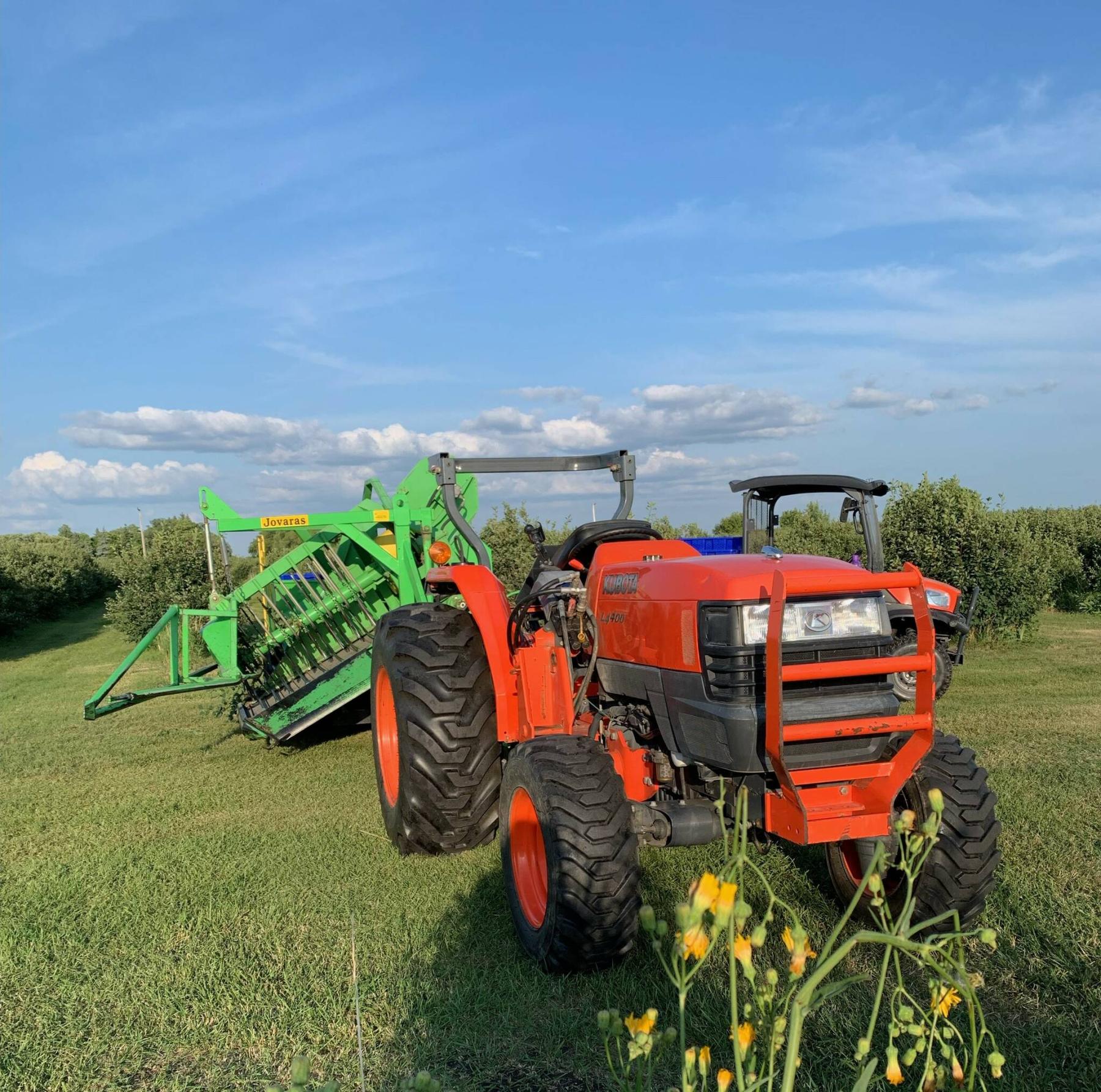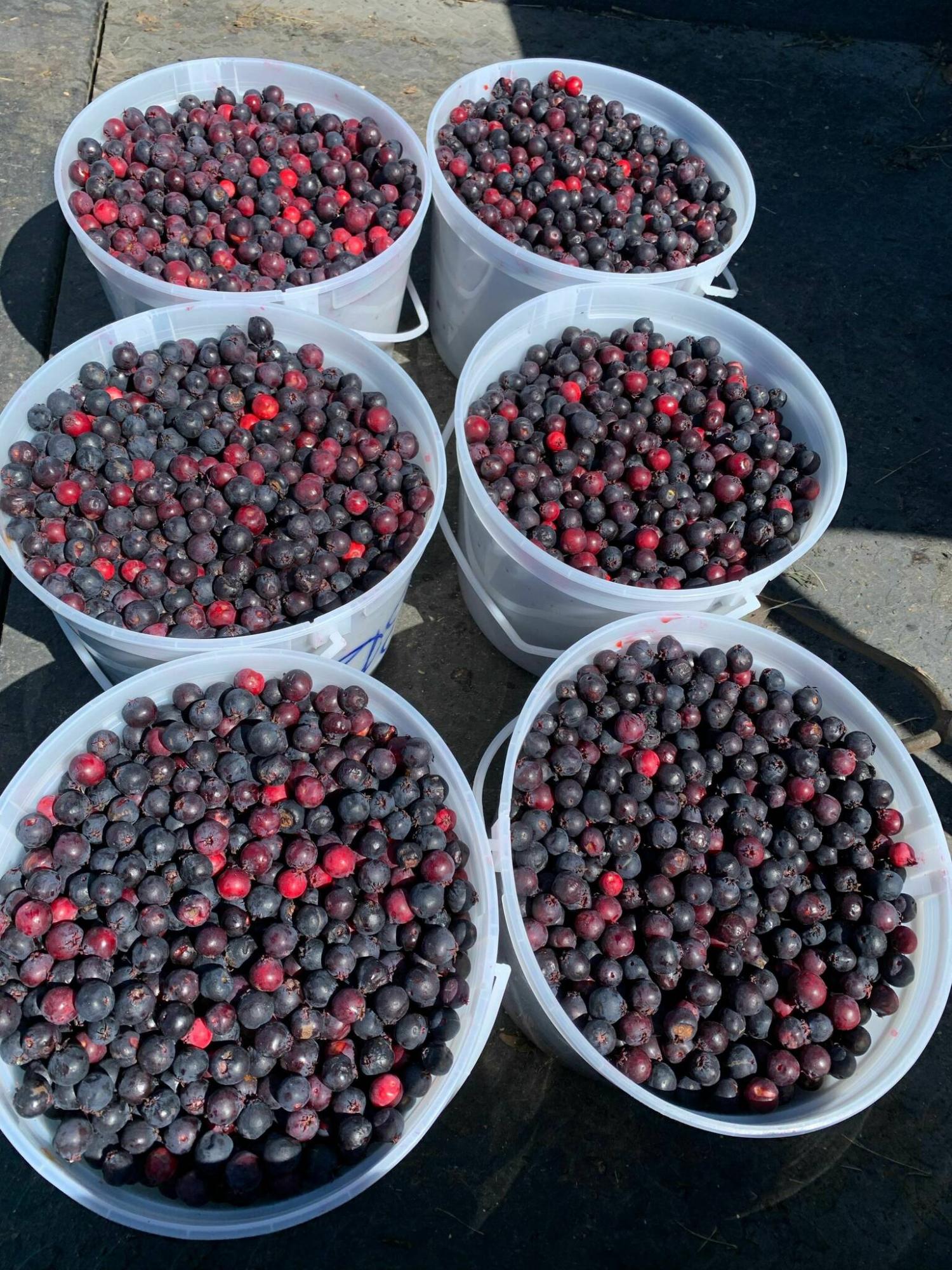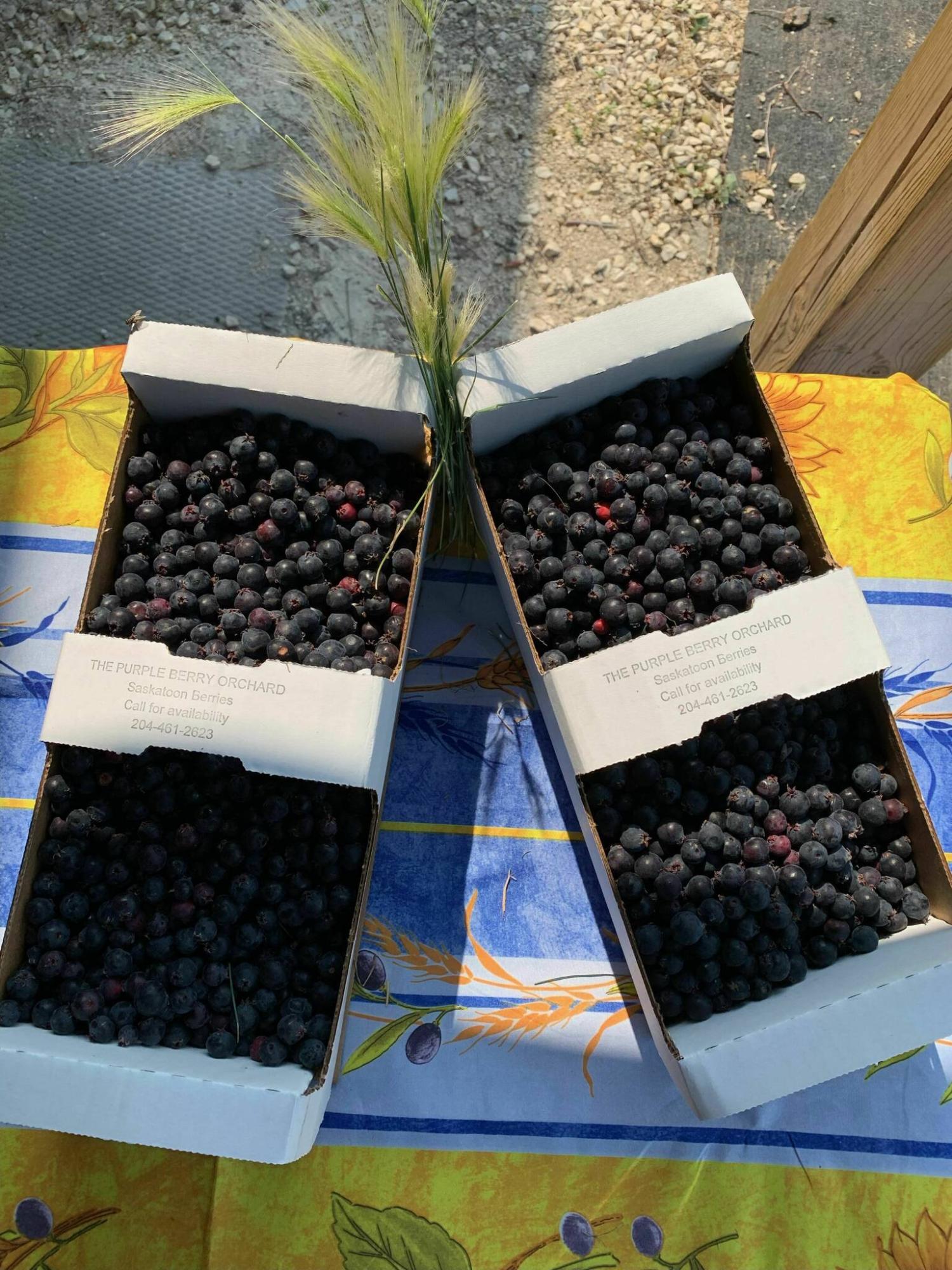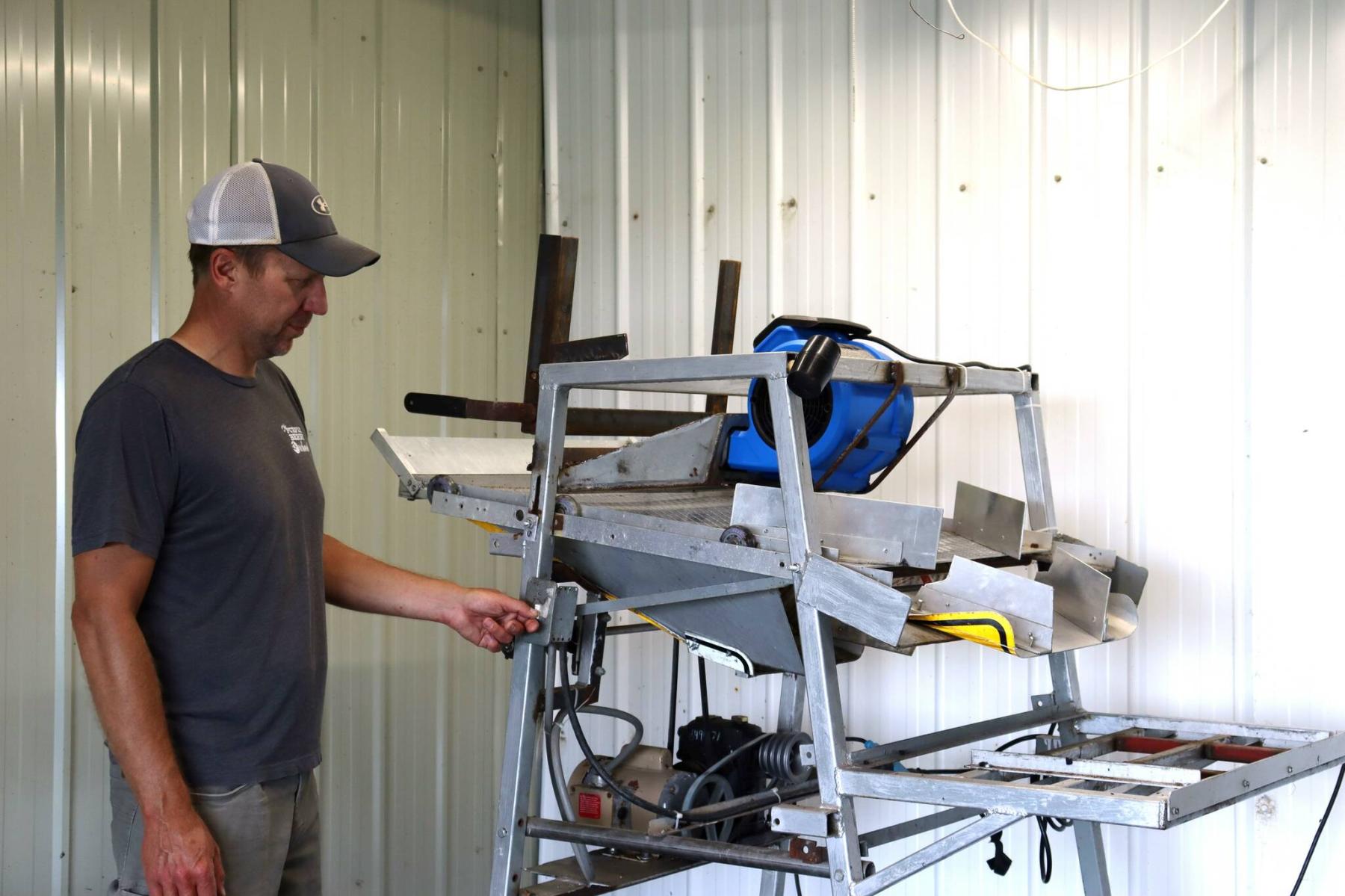
The Purple Berry Orchard
This Jovaras harvester is used to harvest saskatoon berries which are then frozen for market.

The Purple Berry Orchard
Next summer, when it’s saskatoon berry season, fill your pail with fresh berries at The Purple Berry Orchard U-pick.

The Purple Berry Orchard
With demand growing for their delicious, nutritious saskatoon berries, The Purple Berry Orchard sold out of their four-litre boxes of berries quickly this year.

Colleen Zacharias / Free Press
Brent Wolfe, co-owner of The Purple Berry Orchard, beside the berry cleaner that he built.
There was one year when The Purple Berry Orchard needed to put up a sign that said, “Sorry, we don’t grow strawberries.” Today, the customers who flock annually to The Purple Berry Orchard know exactly what they are looking for: large quantities of saskatoon berries, fresh or frozen.
The Purple Berry Orchard is a family owned and operated saskatoon orchard just outside of Winnipeg on the Perimeter Highway, one kilometre south of Rosser Road. When the saskatoons are in season, they are harvested on a u-pick basis. Brent and Sheila Wolfe, owners, also sell frozen saskatoon berries year-round. But not this year. Their entire inventory of frozen saskatoon berries sold out weeks ago. Simply put, demand for saskatoon fruit far exceeds supply.
I recently visited with Brent and Sheila Wolfe at their orchard site near Rosser. One of the things I wanted to learn about was the viability of the saskatoon (Amelanchier alnifolia) both as a u-pick crop and a backyard fruit. The saskatoon, which is also called serviceberry or June berry, is the size of a large shrub or small tree (5 to 12 feet tall). Classified as Zone 2, the saskatoon has exceptional cold hardiness. Native to Manitoba, it can take winter temperatures as cold as minus 45 degrees Celsius or colder.
Brent and Sheila opened my eyes to the demand for fresh and frozen saskatoon fruit especially by people who live in urban areas but also to their high nutritional value and all that’s involved in growing and harvesting saskatoons. But first, let me tell you a bit more about this remarkable couple.
Brent works for Manitoba Agricultural Services Corporation in crop insurance and is a director with the Prairie Fruit Growers Association. Sheila is a research assistant (entomology) at Agriculture and Agri-Food Canada. They raised cattle and grew grain until 2006 when they started The Purple Berry Orchard where they operate a nine-acre u-pick. They also have an eight-acre site at Stonewall where they mechanically harvest saskatoons which they clean and sell frozen in four-litre boxes. This year, Brent and Sheila took over a research orchard in Stonewall where they are evaluating nine different varieties of saskatoon.
They have four children ages 14, 17, 21 and 33.
“Our kids have grown up helping us with the berries,” said Sheila. Brent’s parents live on the same property as The Purple Berry Orchard and are involved with retail sales of the frozen berries. “They are our whole labour force,” said Sheila.
There is row upon row of mature saskatoon shrubs at The Purple Berry Orchard.
“We planted 800 an acre,” said Brent. “They spread so we planted them three feet apart and then they spread to fill in.” The main variety they grow is called Northline. There are several different varieties of hardy saskatoon including Honeywood, Martin, Parkhill, Smoky, and Thiessen. Northline is one of the tallest varieties (up to 5 metres).
Saskatoons are well suited to sandy loam soil.
“If you talk to any expert or read any book about the ideal soil conditions for growing saskatoons, we are growing them in the wrong spot,” said Brent. “But heavy clay is what we have so this is where we are growing them.” Their saskatoon crop is healthy and thriving.
“When the plants were young,” said Brent, “we had issues early on because they were either too wet or the soil was drying out. Clay soil holds moisture well, but it also cracks when it gets really dry. In 2021 when there was severe drought, the heavy clay held the moisture and we had probably our biggest crop ever on this orchard.”
They also grow some haskap which in comparison to saskatoon is a significantly smaller shrub.
“With the haskap you have to bend down and pick the individual berries one at a time but with the saskatoon, you can pick your berries standing up and it’s easier to fill your bucket much more quickly because the berries are in clusters,” said Sheila. “When the saskatoons are ripe, they roll off into your hand.”
This year the saskatoons ripened about a week later than usual. “It was so cloudy in spring and not very many sunny days,” said Sheila. “The ripening was very uneven which is not something we are used to and then all of a sudden, everything was ripe.”
This year was a shorter season than usual, as well, because the cool conditions that had lasted throughout spring and into early summer suddenly transitioned to high heat and humidity. The u-pick season lasted only five or six days.
“Every year is different. You have to be adaptable,” said Brent. “We decided, okay, the berries are ripening too fast, so we have to run the harvester.”
The mechanical harvester, purchased in 2013, is a Jovaras black currant harvester from Lithuania. Brent modified it for harvesting of the saskatoon berries. “The harvester can get 20 lbs. of fruit in under a minute,” said Brent. “Without it, we would lose so much fruit to over-ripening, but the harvester gives us the opportunity to freeze the berries at their peak.”
Saskatoon berries freeze well and have great flavour, said Sheila. Many of their customers buy as many as 6 to 10 boxes of frozen berries for use during the winter months. “We just needed more berries this year to meet the demand!”
Brent and Sheila have a large walk-in freezer. The berries are frozen in harvest totes before they are cleaned. Then the berries are run through a berry cleaner which Brent built and modified over the years before they are returned to the freezer. They sell berries for both the wholesale and retail market. Some of the wholesale berries are used for perogies.
Northline berries freeze individually so you don’t have to put them on cookie sheets. The berries are great for baking, said Sheila. “Some fruit like strawberries get a little mushy but Northline saskatoons keep their shape and texture when they thaw.”
When Sheila makes muffins, she lets the berries thaw out slightly and then coats them with a bit of flour before adding them to the batter to prevent them from turning the batter blue.
Saskatoon berries are higher in antioxidants than blueberries, said Brent. “Studies were done by the Saskatoon Berry Council of Canada. People appreciate that saskatoons are a very healthy berry, but people don’t come to pick berries to save their life — they just like how they taste. The local market is growing as more people find out about saskatoons, especially as new Canadians find out what saskatoons are,” said Brent. “Whole families are looking for that activity.”
Weeks after the u-pick season ended, their phone was still ringing every day from callers who wanted to pick saskatoons.
The beverage market is also discovering saskatoons. Craft breweries are showing interest and there is an up-and-coming market for saskatoon berry tea using freeze-dried berries, said Sheila.
Saskatoons are self-pollinating. If you would like to try growing one, choose a well-drained location that receives full sun. If you plan to pick berries at The Purple Berry Orchard next year, visit www.purpleberryorchard.com.




